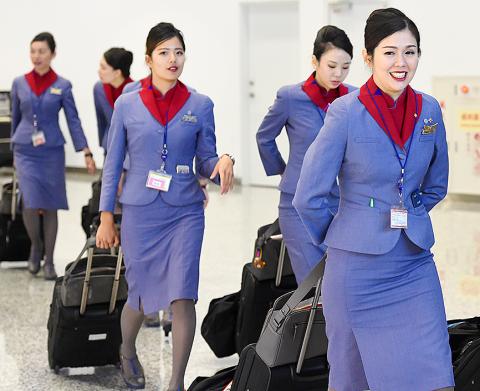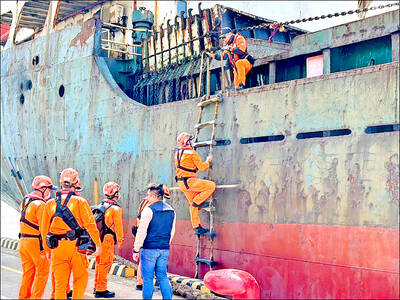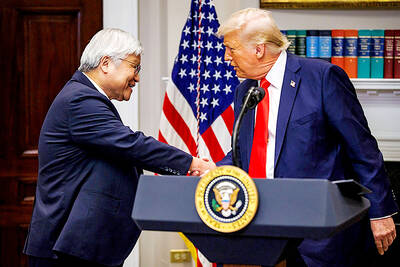The Civil Aeronautics Administration (CAA) yesterday said it would ask China Airlines (中華航空) to provide details of its flight attendant internship program following criticism from lawmakers and cabin crew.
The nation’s largest airline on Wednesday announced that it would recruit 24 flight attendant interns through its partnerships with four universities: National Kaohsiung University of Hospitality and Tourism, Vanung University, China University of Science and Technology and Ming Chuan University.
The internship is to last one year, with each intern required to undergo a two-month flight attendant training and pass an evaluation before they are allowed to work on flights, the airline said.

Photo: Chu Pei-hsiung, Taipei Times
Interns are to fly 60 hours per month, for which they are to receive a scholarship of NT$150,000 per semester, it added.
The program has drawn opposition from the Taoyuan Flight Attendants Union, which is comprised of mostly China Airlines flight attendants who succeeded in shutting down the carrier in 2016 through a strike.
“This is an example of how a Taiwanese company exploits workers. What interns would have to do is almost exactly the same as flight attendants officially employed by the airline. However, the interns would not receive a ‘scholarship’ commensurate to the amount of work they would do,” the union said in a statement on Facebook.
It also asked whether the Labor Standards Act (勞動基準法) would apply to the interns, and whether they would receive the same compensation as flight attendants if they are injured or killed while working.
The internship program is the only one of its kind in the world and sets the worst example, it said.
The Legislative Yuan’s Transportation Committee yesterday also scrutinized the program.
New Power Party Legislator Hung Tzu-yung (洪慈庸) asked the CAA if any other airlines worldwide also recruit flight attendant interns.
She asked the agency to strictly review the program, saying that it should not allow the carrier to offer the program without thoroughly considering consumer interests.
“We are not saying that interns are not good enough to do the job, but we have to consider if [full-time] flight attendants have the time and capacity to train interns,” Hung said.
CAA Director-General Lin Kuo-hsien (林國顯) said China Airlines has applied to offer the internship program, but the agency has asked the airline to provide more information regarding the program, including whether it fulfills Ministry of Education and aviation safety requirements.
Flight attendants must be trained and meet certain criteria before they can work on flights, he said.
If program members are considered formal employees, they would have to be hired and treated based on rules applicable to all flight attendants, Lin said, adding that if they are just interns, they should not count toward cabin crew minimum staffing requirements.
China Airlines said the program is unrelated to the normal development of flight attendants, as it aims to help interns gain an understanding of the industry and enable the company to develop talent.

A Chinese freighter that allegedly snapped an undersea cable linking Taiwan proper to Penghu County is suspected of being owned by a Chinese state-run company and had docked at the ports of Kaohsiung and Keelung for three months using different names. On Tuesday last week, the Togo-flagged freighter Hong Tai 58 (宏泰58號) and its Chinese crew were detained after the Taipei-Penghu No. 3 submarine cable was severed. When the Coast Guard Administration (CGA) first attempted to detain the ship on grounds of possible sabotage, its crew said the ship’s name was Hong Tai 168, although the Automatic Identification System (AIS)

An Akizuki-class destroyer last month made the first-ever solo transit of a Japan Maritime Self-Defense Force ship through the Taiwan Strait, Japanese government officials with knowledge of the matter said yesterday. The JS Akizuki carried out a north-to-south transit through the Taiwan Strait on Feb. 5 as it sailed to the South China Sea to participate in a joint exercise with US, Australian and Philippine forces that day. The Japanese destroyer JS Sazanami in September last year made the Japan Maritime Self-Defense Force’s first-ever transit through the Taiwan Strait, but it was joined by vessels from New Zealand and Australia,

SECURITY: The purpose for giving Hong Kong and Macau residents more lenient paths to permanent residency no longer applies due to China’s policies, a source said The government is considering removing an optional path to citizenship for residents from Hong Kong and Macau, and lengthening the terms for permanent residence eligibility, a source said yesterday. In a bid to prevent the Chinese Communist Party (CCP) from infiltrating Taiwan through immigration from Hong Kong and Macau, the government could amend immigration laws for residents of the territories who currently receive preferential treatment, an official familiar with the matter speaking on condition of anonymity said. The move was part of “national security-related legislative reform,” they added. Under the amendments, arrivals from the Chinese territories would have to reside in Taiwan for

CRITICAL MOVE: TSMC’s plan to invest another US$100 billion in US chipmaking would boost Taiwan’s competitive edge in the global market, the premier said The government would ensure that the most advanced chipmaking technology stays in Taiwan while assisting Taiwan Semiconductor Manufacturing Co (TSMC, 台積電) in investing overseas, the Presidential Office said yesterday. The statement follows a joint announcement by the world’s largest contract chipmaker and US President Donald Trump on Monday that TSMC would invest an additional US$100 billion over the next four years to expand its semiconductor manufacturing operations in the US, which would include construction of three new chip fabrication plants, two advanced packaging facilities, and a research and development center. The government knew about the deal in advance and would assist, Presidential